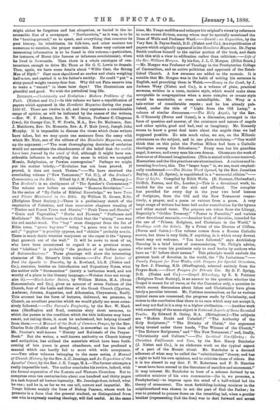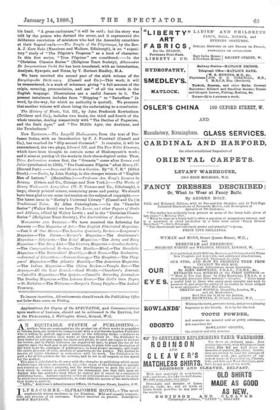Drvimry.—Christianity and Evolution : Modern Problems of the Faith. (Nisbet
and Co.)—In this volume we have a republication of papers which appeared in the Homiletic Magazine during the years 188687. There are twelve in all, and they represent a considerable range of opinion, as will be indicated by the names of the writers, —Rev. W. F. Adeney, Rev. R. W. Dorton, Professor C. Chapman (two), Sir George Cox, T. W. Fowle, M.A., Rev. Dr. Matheson, Rev. J. Matthews, Rev. Dr. Momerie, Rev. A. F. Muir (two), Joseph John Murphy. It is impossible to discuss the views which these writers have taken, but we may quote one sentence from the essay with which Mr. Muir, one of the editors of the Homiletic Magazine, sums up the argument :—" The most thoroughgoing doctrine of evolution would not necessitate the abandonment of the belief that the worlds have been framed by the word of God, although it might have con- siderable influence in modifying the sense in which we accepted Mosaic, Babylonian, or Persian cosmogonies." Perhaps we might put the matter briefly,—" Evolution has not been proved. If proved, it does not touch Theism."—We have received the ooncluding volume (" New Testament," Vol. IL), of the Student's Commentary on the Bible. Edited by J. M. Faller, MA. ( Hurray.) — The Student's is an abridgment of "The Speaker's Commentary." The volume now before us contains " Romans-Revelation."— In the series of "By-Paths of Biblical Knowledge," we have Trees and Plants Mentioned in the Bible. By William H. Groser, B.Sc. (Religious Tract Society.) —There is a preliminary sketch of the vegetation of Palestine, and then successive chapters treating of Timber and Forest Trees and Shrubs," "Fruit Trees and Shrubs," "Grain and Vegetables," "Herbs and Flowers," "Perfumes and Medicines." Mr. Groser inclines to think that the " almug " tree was the red sandal-wood. The " bay " must disappear from the list of Bible trees, "green bay-tree" being "a green tree in its native soil ;" "gopher" is possibly cypress, and " shittim " probably acacia. There is much doubt whether marjoram or the caper is the "hyssop that groweth out of the wall." It will be news to most of us, who have been accustomed to regard it as a precious stone, that " bdelliam " is probably "the produce of an Indian species of Balsamod.endron." These gleanings will show the interesting character of Mr. Groser'a little volume.—The First Letter of Paul the Apostle to Timothy, by A. Rowland, LL.B. (Nisbet and Co.), contains, besides an Introduction and Expository Notes, what the author calls " Sermonettes" (surely a barbarous word, and not worthy of a ple.oe in the literary language,—Webster does not recog- nise it).—Black-Letter Saints, by William Malam, M.A. (Swan Elonnenschein and Co.), gives an account of seven Fathers of the Church, four of the Latin and three of the Greek Church (Cyprian, Ambrose, Jerome, Augustine, and Athanasius, (Jhrysostom, Basil). This account has the form of lectures, delivered, we presume, in Church, an excellent practice which we would gladly see more exten- sively followed.—The Parson's Perplexity, by the Rev. W. Hard- man (Skeffington and Son), contains sixty short sermons, to which the parson in the condition which the title indicates may have resort, not taking them, it mast be understood, but helping himself from them.—A Manual of the Book of Common Prayer, by the Rev. Charles Hole (Hodder and Stoughton), is somewhat on the lines of Mr. Procter's well-known "History and Rationale of the Prayer- Book." But the writer, a well-known authority on Church history and antiquities, has utilised the materials which have been forth- coming of late years in great abundance, and has produced a manual which can hardly fail to meet with wide acceptance. —Two other volumes belonging to the same series, A Manual ef Church. History, by the Rev. A. C. Jennings, and An Exposition of the Apostles' Creed, by the Rev. J. E. Yonge, M.A.—The former attempts a really impossible task. The author conclndes his review, indeed, with the formal separation of the Eastern and Western Churches. Bat to compress even ten centuries into about one hundred and thirty pages is a task beyond all human ingenuity. Mr. Jennings does, indeed, what he can ; and he is, as far as we can tell, correct and impartial. Mr. Yonge follows mainly the lines of Bishop Pearson, whose work he presents in a form that the general student, as distinguished from one who is expressly reading theology, will find useful. At the same time, Mr. Yonge modifies and enlarges his original's views by reference to more recent divines, among whom may be specially mentioned the Dean of Wells and Professor Ward.—Daniel : an Exposition, by the Very Rev. R. Payne Smith, D.D. (Nisbet and Co.), is a republication of papers which originally appeared in the Homiletic Magazine. Dr. Payne Smith confines himself to the earlier portion of the book, and deals with this with a view to edification rather than criticism.—Life of the Rev. William Morgan. By his Son, J. L. C. Morgan. (Elliot Stook.) —Mr. Morgan was Professor of Theology in the Presbyterian College of Carmarthen, and an active politician and opponent of the Estab- lished Church. A few sermons are added to the memoir. It is notable that Mr. Morgan was in the habit of writing his sermons in English, and preaching them in Welsh.—Honey in the Comb, by J. Jackson Wray (Nisbet and Co.), is a volume of plain, practical sermons, written in a terse, incisive style, which would make them acceptable to congregations when a more complex or ornate style would be unsuitable, or even unintelligible. Mr. Wray is a tale-writer of considerable repute ; and he has already pub- lished, under the title of "Light from the Old Lamp," a volume of similar discourses.—The Holy Angels, by the Rev. R. O'Kennedy (Burns and Oates), is a discussion, arranged in the form of question and answer, of the existence and nature of angels and other spirits, good and bad, real or imaginary. Mr. Kennedy seems to know a great deal more about the angels than we had supposed possible. He sets much value, we see, on the Miltonic utterances on the subject, and in one place exclaims,—" One would think that on this point the Puritan Milton had been a Catholic theologian among the Schoolmen." Every man has his guardian angel, it seems, and every man his own demon. Ghosts are the work of demons or of diseased imaginations. (This is stated with some reserve). Mesmerism and the like practices are abominations. A curious and in- teresting brochure, this. The "larger hope" is, we see, most emphati- cally condemned.—The Divine Word Opened, by the Rev. Jonathan Bayley, A.M. (J. Speirs), is republished in a "memorial edition."— Rays of Light. Compiled by Edith Wells. (E. Durant, Chelmsford; Griffith, Farran, and Co., London.)—This is a devotional work, in- tended for the use of the sick and afflicted. The compiler has provided for every day in the year two brief lessons of Scripture, from the Old and the New Testament respec- tively, a prayer, and a poem or extract from a poem. A very large range of writers has been laid under contribution for the hymns and other sacred verse. The prayers are taken from the Liturgy, Bogatzky's "Golden Treasury," "Pastor in Parochia," and various other devotional manuals.—Another book of devotion, intended for the use of "Priests, Religious, and Christians in the World," is Readings with the Saints. By a Priest of the Diocese of Clifton. (Barns and Oates.)—The volume comes from a Roman Catholic source, but there is very little, if anything, in it which every devout heart may not welcome. "You have followed," says Archbishop Manning in a brief letter of commendation, "St. Philip's advice, who used to warn his penitents only to read books by authors who have an S.' before their names." This principle would exclude the greatest book of devotion in the world, the "Be Imitatione."— Family Prayers for Four Weeks, with Prayers for Special Occasions, by Rev. J. Fleming, B.D. (Skeffington), selected entirely from the Prayer-Book.—Short Prayers for Private Use. By D. F. Sprigg, D.D. (Nisbet and Co.)—Gospel Ethnology, by S. R. Pattison (Religious Tract Society), is an answer to the question whether the Gospel is meant for all races, or for the Caucasian only, a question to which recent discussions about Islam and Christianity have given lately a peculiar interest. Mr. Pattison summarises, as far as various typical races are concerned, the progress made by Christianity, and comes to the conclusion that there is no race which may not accept it and may not find in it a step to a higher civilisation.—Another work with something of the same object is Rational Aspects of Some Revealed Truths. By Edward B. Ottley, M.A. (Rivingtons.)—The subjects are "Modern Doubt and Unbelief ;" "The Authority of the Holy Scriptures ;" "The Divinity of Christ," the argument being treated under three heads, "The Witness of the Church," "The Hebrew Scriptures," and "The New Testament ;" and, finally, "Christianity and Culture."—The Levitical Sin-Offering : its Christian. Fulfilments and Uses, by the Rev. Henry Batchelor (J. Nisbet and Co.), is an elaborate work on the typical aspect of a part of the Mosaic ritual. Mr. Batchelor is a devoted adherent of what may be called the " substitutional " theory, and has a right to hold his own opinions, and to criticise those of others. But it is too absurd to say that F. W. Robertson and F. D. Maurice "must have been unread in the literature of sacrifice and atonement." It may interest Mr. Batchelor to hear of a scheme devised by an orthodox minister of his own communion—(he is, we presume, a Presbyterian)—to impress upon the mind of a half-witted lad the theory of atonement. The most forbidding-looking minister in the neighbourhood was chosen to act the part of God the Father ; he was to pretend to pounce down on the trembling lad, when a gentler brother (representing God the Son) was to dart forward and arrest
his hand. "A gross caricature," it will be said ; but the story was told by the person who devised the scene, and it represented the deliberate conviction of ministers who had the Assembly catechism at their fingers'-ends.—The People of the Pilgrimage, by the Rev. A. J. Kerr Bain (Mtioniven and Wallace, Edinburgh), is an exposi- tory " study of "The Pilgrim's Progress" as a book of character. In this first series, "True Pilgrims" are considered.—In the "Christian Classics Series" (Religions Tract Society), Athanasius De Incarnations Verbi Dei has been translated, with an Introduction, Analysis, Synopsis, and Notes, by T. Herbert Bindley, MA.







































 Previous page
Previous page